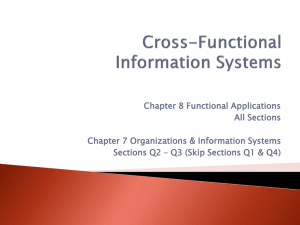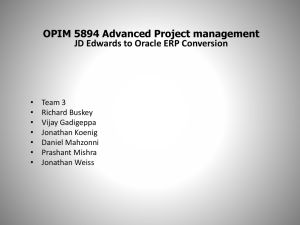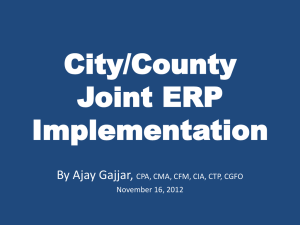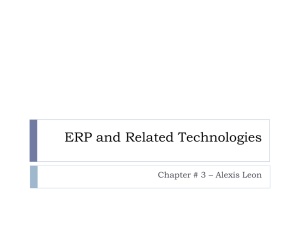MIS5670Notes9
advertisement
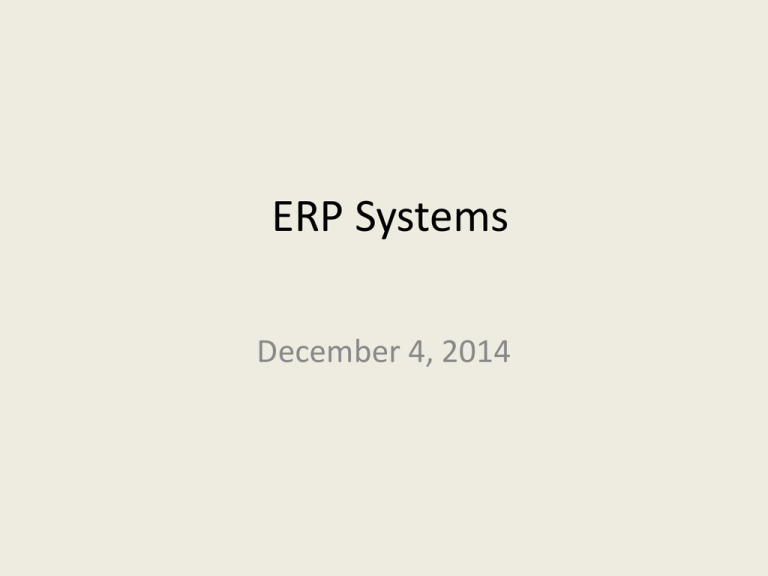
ERP Systems December 4, 2014 Generic ERP system 2 Categories of ERP systems • By size and complexity – Enterprise-grade packages – Midmarket solutions – Small business packages • By specialization – Generic packages (can be customized to an extent) – Specialized packages (by industry) • Example: Banner ERP includes Banner Student, Banner Finance, Banner Human Resources, Banner Financial Aid, and Banner Advancement. • Example: Infor Industrial Manufacturing SAP ERP solutions • • • • • • Financial Accounting (FI) Financial Supply Chain Management (FSCM) Controlling (CO) Materials Management (MM) Sales and Distribution (SD) Logistics Execution (LE) • • • • • Production Planning (PP) Quality Management (QM) Plant Maintenance (PM) Project System (PS) Human Resources (HR) 4 Oracle E-Business Suite • • • • • • • • • • • • • • • • Accounts payable (AP) General Ledger Order Management (OM) Oracle CRM Oracle Financials Oracle HRMS Oracle Mobile Supply Chain Applications Oracle Order Management Oracle Procurement Oracle Property Manager Oracle Project Portfolio Management Oracle Quotes Oracle Transportation Management Oracle Warehouse Management Systems Oracle Inventory Management (INV) Oracle Enterprise Asset Management 5 Free and open-source ERP software • ERP solutions for small and medium-size business. Name Platform Description Origin ERPNEXT JavaScript, MySQL, Python, General Public License Functions: billing, inventory, supply chain management, production planning, HR, customer relationship management. GNU Enterprise Python, General Public License HR, Accounting, CRM, project management, SCM, e-commerce OpenERP Python, Javascript, PostgreSQL, General Public License CRM, Accounting, Sales, POS, HR, Manufacturing, Project Management, Warehouse, Purchase. WebERP PHP, MySQL, LAMPbased system, General Public License Sales & Orders, Taxes, Accounts receivables, Inventory, Purchasing, Account payables, Manufacturing, ERP Life cycle Acquisition Installation & Configuration Use & Maintain 7 ERP Implementation: Who is involved? Key actors Life cycle stage Measure of success Users Senior manager Project manager IT staff ERP consultant 8 ERP system selection methodologies • • • SpecIT Independent Vendor Selection Clarkson Potomac method In-house purchase process 9 ERP system selection • • SDLC SpecIT Independent Vendor Selection ERP selection process model Source: Avram C, Zota R, Ciovita L, (2012), Developing an ERP Strategy Based On the IT Solution Life Cycle, Economy Informatics 12(1), 2012, p. 35 10 General Selection criteria • • • • • • • • • • • Operating System - requirement for a particular operating system. Database format - requirement for a particular database system Data import or export – the capabilities of export or import data in/from other software packages. The look and feel of the application – requirements for standard windows processes and procedures? Filtering and searching friendliness (this applies to database software) – existence of several optional ways of finding data that the users will need. Look-ups – Look-ups are tables or drop down lists that offer a selection of data to choose from when using the system. User configurability of look-ups and lists - the lists and drop downs mentioned above to be user configurable. Required number of concurrent users. Archiving requirements - archive the data for a number of years Single or multi-site functionality – the possibility that the application supports multi-site operation or it will be installed on a single site. Graphical, hierarchical data structure - database systems which display a graphical representation of a hierarchical structure (parent / child relationships) are 11 generally preferred. General Selection criteria • • • • • • • • • • • Regulatory compliance support – if in user industry there are any statutory standards to which the software must comply. Ease of implementation – the work required to implement the software. Additional database software required - some applications require that licenses are purchased for additional database software. Access to data from various areas - system users may require logging on and inputting or checking data from any work station that has the application installed. Speed of access and response time. Customizable screens - allow the administrator to hide specific fields from defined users. Customization - For example configuration of screens and user configurable data should be intuitive and not requiring a high level of IT knowledge. Customizable reports - Customizable reports allow the user to modify existing reports which is much easier that creating reports from scratch. Password - Users should be allocated passwords. Individuals and group settings – it should be possible to set up individual users ID's as well as user groups. Audit trail - an administration audit trail can be required, that would provide traceability to individuals for all changes to the administration and security module. 12 Web Access and Integration criteria • • • • • • Purchase or rent - Who owns the software? This is an important factor as some web based systems can be purchased and installed on your own Intranet. Others are rented and installed on the vendor's servers. Data ownership - Is there any ambiguity with respect to the ownership of the data? Functionality - Due to limitations in the programming of Web browser based systems some of these packages have limited functionality. Response Speed - Is the response time of the software satisfactory? Cost analysis – In case of renting web based software the cost against that of buying a web based package for installation on your Intranet should be assessed. Customization - Web based software must often be used without customization. If this is the case, will the application meet the requirements in its standard form? 13 Vendor’s specific criteria • • • • • • Stability - each manufacture's stability must be assessed. Mechanism should be in place in case vendor is going out of business. Professionalism - assess each manufacturer for the professionalism displayed in dealing with the client’s inquiry and in demonstrating their products. Service level agreement - assess each vendor for the level of future service and support that they offer. What does it cost for the level of service that you require? Provision of customization - if the application will be customized, each vendor should be assessed for the service they offer in this and costs involved. Upgrade path - if the application is an entry level system that may be upgraded in future, assess the vendor for the upgrade path offered and cost of these upgrades. Customer base - how many packages has the vendor sold and who buys them? 14 TCO criteria • • • • • • Cost of software - assess the application for total cost for the configuration and number of users required. Cost of hardware - the total cost of any additional hardware required to make the implementation work with the application. Potential future cost - assess for potential significant future costs. Implementation cost - installation of the software and consultancy. Training cost - assess for training costs involved in implementing this application. Cost of customization - assess the application for any costs involved in customizing it for your requirements. 15


